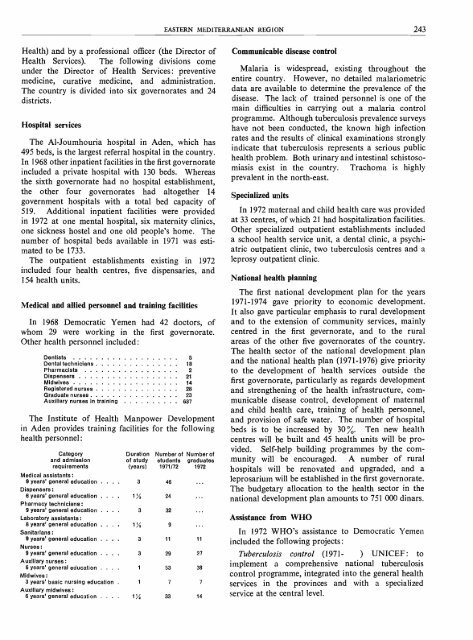FIFTH REPORT - World Health Organization
FIFTH REPORT - World Health Organization
FIFTH REPORT - World Health Organization
Create successful ePaper yourself
Turn your PDF publications into a flip-book with our unique Google optimized e-Paper software.
EASTERN MEDITERRANEAN REGION 243<br />
<strong>Health</strong>) and by a professional officer (the Director of<br />
<strong>Health</strong> Services). The following divisions come<br />
under the Director of <strong>Health</strong> Services: preventive<br />
medicine, curative medicine, and administration.<br />
The country is divided into six governorates and 24<br />
districts.<br />
Hospital services<br />
The Al- Joumhouria hospital in Aden, which has<br />
495 beds, is the largest referral hospital in the country.<br />
In 1968 other inpatient facilities in the first governorate<br />
included a private hospital with 130 beds. Whereas<br />
the sixth governorate had no hospital establishment,<br />
the other four governorates had altogether 14<br />
government hospitals with a total bed capacity of<br />
519. Additional inpatient facilities were provided<br />
in 1972 at one mental hospital, six maternity clinics,<br />
one sickness hostel and one old people's home. The<br />
number of hospital beds available in 1971 was estimated<br />
to be 1733.<br />
The outpatient establishments existing in 1972<br />
included four health centres, five dispensaries, and<br />
154 health units.<br />
Medical and allied personnel and training facilities<br />
In 1968 Democratic Yemen had 42 doctors, of<br />
whom 29 were working in the first governorate.<br />
Other health personnel included:<br />
Dentists 5<br />
Dental technicians 18<br />
Pharmacists 2<br />
Dispensers 21<br />
Midwives 14<br />
Registered nurses 28<br />
Graduate nurses 23<br />
Auxiliary nurses in training 637<br />
The Institute of <strong>Health</strong> Manpower Development<br />
in Aden provides training facilities for the following<br />
health personnel:<br />
.<br />
Category<br />
Duration Number of Number of<br />
and admission<br />
of study students graduates<br />
requirements<br />
(years) 1971/72 1972<br />
Medical assistants :<br />
9 years' general education . 3 46<br />
Dispensers:<br />
6 years' general education . 1''4 24<br />
Pharmacy technicians:<br />
9 years' general education . 3 32<br />
Laboratory assistants:<br />
8 years' general education . 1 % 9<br />
Sanitarians:<br />
9 years' general education . 3 11 11<br />
Nurses:<br />
9 years' general education . 3 29 27<br />
Auxiliary nurses:<br />
6 years' general education . 1 53 38<br />
Midwives:<br />
3 years' basic nursing education 1 7 7<br />
Auxiliary midwives:<br />
6 years' general education . . 1 j 33 14<br />
Communicable disease control<br />
Malaria is widespread, existing throughout the<br />
entire country. However, no detailed malariometric<br />
data are available to determine the prevalence of the<br />
disease. The lack of trained personnel is one of the<br />
main difficulties in carrying out a malaria control<br />
programme. Although tuberculosis prevalence surveys<br />
have not been conducted, the known high infection<br />
rates and the results of clinical examinations strongly<br />
indicate that tuberculosis represents a serious public<br />
health problem. Both urinary and intestinal schistosomiasis<br />
exist in the country. Trachoma is highly<br />
prevalent in the north -east.<br />
Specialized units<br />
In 1972 maternal and child health care was provided<br />
at 33 centres, of which 21 had hospitalization facilities.<br />
Other specialized outpatient establishments included<br />
a school health service unit, a dental clinic, a psychiatric<br />
outpatient clinic, two tuberculosis centres and a<br />
leprosy outpatient clinic.<br />
National health planning<br />
The first national development plan for the years<br />
1971 -1974 gave priority to economic development.<br />
It also gave particular emphasis to rural development<br />
and to the extension of community services, mainly<br />
centred in the first gevernorate, and to the rural<br />
areas of the other five governorates of the country.<br />
The health sector of the national development plan<br />
and the national health plan (1971 -1976) give priority<br />
to the development of health services outside the<br />
first governorate, particularly as regards development<br />
and strengthening of the health infrastructure, communicable<br />
disease control, development of maternal<br />
and child health care, training of health personnel,<br />
and provision of safe water. The number of hospital<br />
beds is to be increased by 30 %. Ten new health<br />
centres will be built and 45 health units will be provided.<br />
Self -help building programmes by the community<br />
will be encouraged. A number of rural<br />
hospitals will be renovated and upgraded, and a<br />
leprosarium will be established in the first governorate.<br />
The budgetary allocation to the health sector in the<br />
national development plan amounts to 751 000 dinars.<br />
Assistance from WHO<br />
In 1972 WHO's assistance to Democratic Yemen<br />
included the following projects :<br />
Tuberculosis control (1971- ) UNICEF: to<br />
implement a comprehensive national tuberculosis<br />
control programme, integrated into the general health<br />
services in the provinces and with a specialized<br />
service at the central level.
















